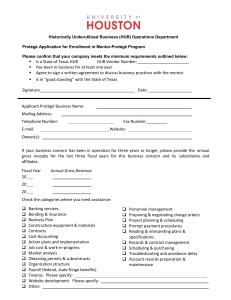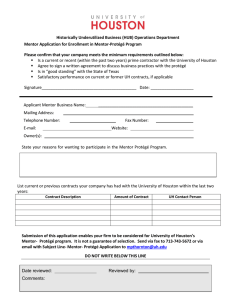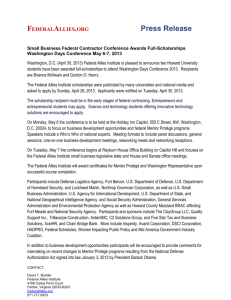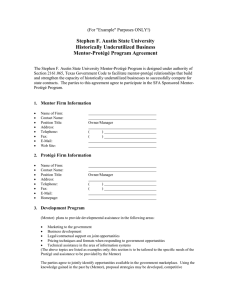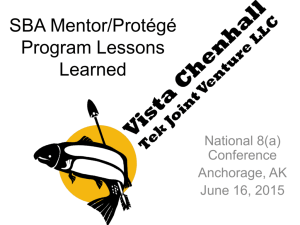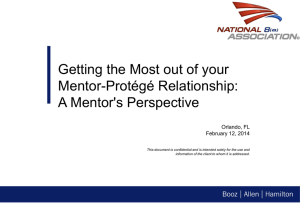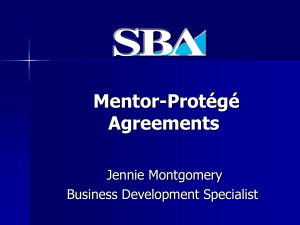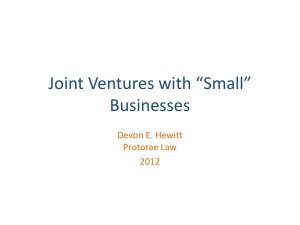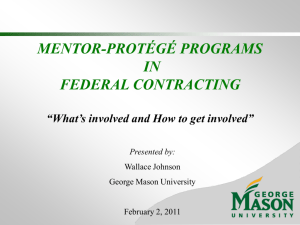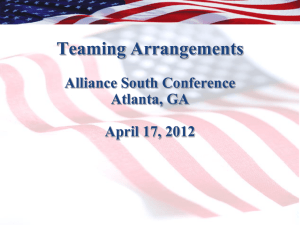2012 SAME Conference, Army Mentor
advertisement
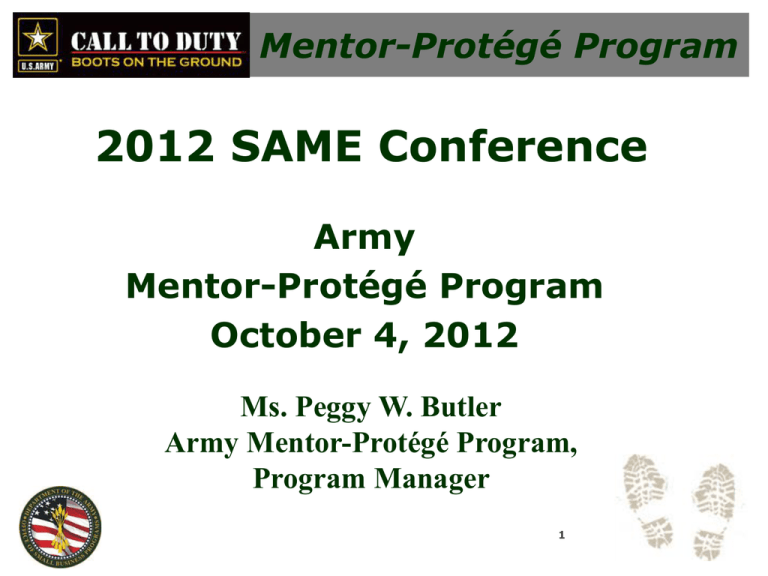
Mentor-Protégé Program 2012 SAME Conference Army Mentor-Protégé Program October 4, 2012 Ms. Peggy W. Butler Army Mentor-Protégé Program, Program Manager 1 Agenda Background Participants Types of Agreements Program Status Program Benefits How to Participate Army Requirements Lessons Learned Technology Transfer 2 Background Established in 1991 - P.L. 101-510 to provide incentives to prime contractors to develop the technical and business capabilities of eligible protégés to increase their participation in both prime contracts and subcontracts An Amendment to The National Defense Authorization Act for FY 2011 extended the MPP until 30 Sep 2015 for approval of new agreements, and until 30 Sep 2018 for incurred costs 3 Who is Eligible? Protégés Certified and Self Certified Small Disadvantaged Business Qualified organizations employing the severely disabled Women-Owned Small Business Indian-Owned Small Business Native Hawaiian Organization-Owned Small Business Qualified HUB zone Small Business Service-Disabled Veteran-Owned Small Business Be eligible for award of Federal contracts 4 Types of Agreements Credit – Allows mentor to receive credit against their SDB subcontracting goals for costs incurred due to development assistance provided to the protégé. Direct Reimbursement – Allows mentor to receive monetary reimbursement of costs incurred due to development assistance provided to the protégé. Hybrid Agreement – Requires mentor to self-fund base year activities (receiving credit against their SDB subcontracting goals for costs incurred), with costs reimbursed in the option year(s). 5 Program Status Currently, the Army has 18 active MentorProtégé agreements Mentor Data: 13 Mentors – 11 Large; 2 Grad 8(a) Protégé Data: 18 Protégé’s – 13 SDB / 8(a) 6 WOSB 4 HUBZone 7 SDVOSB 6 Mentor Benefits Long-term relationship with business partner Qualified source at competitive prices Ability to award subcontracts directly Help achieve subcontracting goals Subcontracting opportunities 7 Protégé Benefits Technology Transfer Technical Management Skills Long-term Relationship Enhanced Competitiveness Subcontracting Opportunities Prime Contracting Opportunities 8 How to Apply Visit our website www.sellingtoarmy.info & click the link for the Mentor-Protégé Program Click the “Legislative & Policy Information” box to view Army Mentor-Protégé Policies & Procedures and Proposal Instructions Click the “Business Development Center” box to retrieve required templates for proposal submission Click the link to view a list of “New Technologies Needed by the Military” 9 Army Requirements Application Process using specific evaluation criteria Stand alone contracts issued by Army Contracting Center-Redstone Arsenal, AL Non-Manufacturing Agreements <$750,000, Manufacturing may be higher but cannot exceed $1 Million a year Tentative Proposal Due Dates for FY 2013; 15 Feb and 15 Jun 10 Approval Process Selection Board Evaluate and rank proposals Recommend highest rated for approval Army Director OSBP approves Funding provided Stand Alone Contract issued Progress monitored 11 Lessons Learned Impediments to success: Subcontracting expectations unrealized Poor communication and weak commitment between Mentor and Protégé Remote geographic location Conflicting goals, lack of program integration Inordinate expense to Protégé There are unreimbursed costs for both the mentor and the protégé 12 Lessons Learned Contributors to Success Compatibility of Mentor and Protégé Strong Management Focus Periodic reviews/modifications of agreement, as needed Assistance aligned with Protégé’s strategic vision Commitment by both parties to the agreement Technology transfer provides potential subcontracting opportunities for the protégé 13 Technology Transfer New Technologies Needed by The Military Faster, Quieter, Safer Helicopters Weapons That Don’t Kill Inventions That Lighten The Soldier’s Load Ultra-Light, Super-Survivable Dune Buggies Unmanned Mini-Submarines High-Speed, Bulletproof Power Boats Anytime Anywhere Communications Robots That Think for Themselves Cheap Liquid Fuel Persistent ‘Wide Area’ Surveillance • Please visit our website for detailed information on the above initiatives 14 Points of Contact • Army MPP – Peggy W. Butler, Program Manager – Email: peggy.w.butler.civ@mail.mil – Marina Sullivan, Contractor Program Management Support, New Concepts Management Solutions – Email: marina.g.sullivan.ctr@mail.mil Please visit our website www.sellingtoarmy.info Or call us at (703) 697-2868 15
